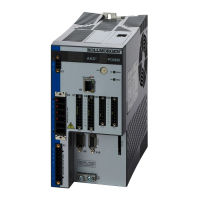AKD User Guide | 10 Configuring General Drive Settings
10.3.1 Digital Inputs 1 and 2
These inputs (X7/9 and X7/10) are particularly fast and are therefore suitable for latch functions, for example.
They can also be used as 24 V inputs for electronic gearing (=> p. 1)
Technical characteristics
l Floating, reference common line is DCOM7
l Sink or Source type sensors possible
l High: 15 to 30 V/2 to 15 mA , Low: -3 to 5 V/<15 mA
l Update rate: Hardware 2 µs
10.3.2 Digital Inputs 3 to 7
These inputs are programmable with the setup software. By default,all inputs are not programmed (off).
For more information refer to the setup software.
Technical characteristics
Choose the function you require in WorkBench.
l Floating, reference common line is DCOM7 or DCOM8
l Sink or Source type sensors possible
l High: 15 to 30 V/2 to 15 mA, Low: -3 to 5 V/<15 mA
l Update rate: Software 250 µs
10.3.3 Digital Input 8 (ENABLE)
Digital Input 8 (terminal X8/4) is set to Enable function.
l Floating, reference common line is DCOM8
l Sink or Source type wiring is possible
l High: 15 to 30 V/2 to 15 mA , Low: -3 to 5 V/<15 mA
l Update rate: direct connection to hardware (FPGA)
The output stage of the drive is enabled by applying the ENABLE signal (Terminal X8/4, active high). Enable is
possible only if input STO has a 24 V signal (see page 1). In the disabled state (low signal) the connected motor
has no torque.
A software enable by means of the setup software is also required (AND link), although this can also be per-
manently enabled with WorkBench.
94 Kollmorgen | December 2010

